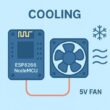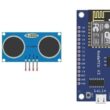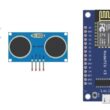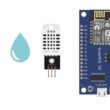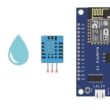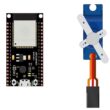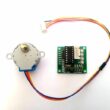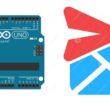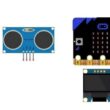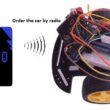The HC-06 Bluetooth module
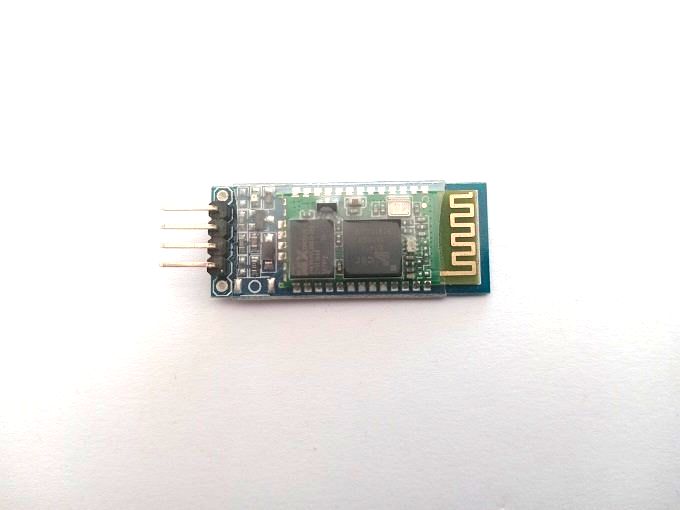
What is the HC-06 Bluetooth module ?
The HC-06 Bluetooth module is a low-cost Bluetooth module that can be used to add wireless communication capabilities to a variety of electronic devices, including microcontrollers, smartphones, and computers. It is based on the Bluetooth 2.0+EDR (Enhanced Data Rate) specification and uses a UART serial interface to communicate with external devices.
The HC-06 module operates as a slave device, which means that it can only be paired with a master device, such as a smartphone or a computer, and cannot initiate a connection on its own. It has a range of up to 10 meters and supports a maximum data transfer rate of 2.1 Mbps.
The HC-06 module is often used in robotics, home automation, and other DIY projects where wireless communication is required. It can be programmed using AT commands to configure its settings, such as the Bluetooth device name, pairing code, and baud rate. It can also be used with a variety of microcontrollers, such as Arduino and Raspberry Pi, to add Bluetooth connectivity to the project.
The composition of the HC-06 Bluetooth module
The HC-06 Bluetooth module is a small electronic device that is composed of several components, including:
1- Bluetooth chip: The core component of the HC-06 module is a Bluetooth chip that provides wireless communication capabilities. The module uses the Bluetooth 2.0+EDR specification and supports the Serial Port Profile (SPP) for serial communication.
2- Antenna: The module has an onboard antenna that is used to transmit and receive Bluetooth signals. The antenna is usually a small, printed circuit board (PCB) trace antenna that is integrated into the module.
3- Voltage regulator: The HC-06 module requires a stable power supply to operate, so it is equipped with a voltage regulator that converts the input voltage to a stable 3.3V or 5V DC output voltage.
4- LEDs: The module typically has two LEDs that indicate the status of the Bluetooth connection. One LED indicates the power status, while the other indicates the connection status.
5- Serial interface: The HC-06 module uses a serial interface to communicate with external devices, such as microcontrollers, smartphones, and computers. The module typically has a 4-pin header that provides access to the serial interface, including the transmit (TX) and receive (RX) pins, as well as the power and ground pins.
How does the HC-06 Bluetooth module work ?
The HC-06 Bluetooth module works by establishing a wireless communication link between two Bluetooth-enabled devices, such as a microcontroller and a smartphone or a computer. The module operates in slave mode, which means that it can only be connected to a master device and cannot initiate a connection on its own.
The module communicates with external devices using a serial interface, which allows it to send and receive data over Bluetooth. The module uses the Serial Port Profile (SPP) to emulate a standard serial port, which makes it easy to integrate with a variety of microcontrollers, such as Arduino and Raspberry Pi.
To use the HC-06 module, it must first be paired with a master device, such as a smartphone or a computer. This is typically done by entering a pairing code or passkey on the master device, which establishes a secure Bluetooth connection between the two devices.
Once the HC-06 module is paired with a master device, it can be used to send and receive data over Bluetooth. For example, if the module is connected to a microcontroller, it can be used to send sensor data or receive commands from a smartphone app. Conversely, if the module is connected to a smartphone or computer, it can be used to send commands or receive data from a microcontroller.
The HC-06 module uses a standard AT command set to configure its settings, such as the Bluetooth device name, pairing code, and baud rate. These commands can be sent to the module using a serial terminal program, such as PuTTY or TeraTerm.
Which microcontrollers are compatible with the HC-06 Bluetooth module ?
The HC-06 Bluetooth module is compatible with a wide range of microcontrollers, including popular development boards like the Arduino and Raspberry Pi. This is because the module communicates with external devices using a standard serial interface, which is supported by most microcontrollers.
To use the HC-06 module with a microcontroller, you will need to connect the module to the microcontroller's serial pins, which are usually labeled TX (transmit), RX (receive), and ground. The exact pinout will depend on the specific microcontroller board you are using, so you should refer to the board's documentation for the pinout information.
Once the module is connected to the microcontroller, you can use software libraries or code examples to communicate with the module using the standard serial interface. For example, on an Arduino board, you can use the Serial library to send and receive data over the HC-06 module.
In addition to the Arduino and Raspberry Pi, the HC-06 module is compatible with a wide range of other microcontrollers, including:
- PIC microcontrollers
- AVR microcontrollers
- ARM microcontrollers
- STM32 microcontrollers
Programming the HC-06 module
The HC-06 Bluetooth module is typically programmed using AT commands, which are simple text commands that can be sent to the module over a serial connection. These commands are used to configure various settings on the module, such as the Bluetooth device name, pairing code, and baud rate.
To program the HC-06 module, you will need a serial terminal program, such as PuTTY or TeraTerm, and a USB-to-serial converter or a microcontroller board with a built-in USB-to-serial converter. Here are the general steps to program the HC-06 module:
1- Connect the HC-06 module to the serial port of the USB-to-serial converter or microcontroller board. Make sure to connect the TX pin of the module to the RX pin of the converter/board, and the RX pin of the module to the TX pin of the converter/board.
2- Connect the USB-to-serial converter or microcontroller board to your computer using a USB cable.
3- Open a serial terminal program on your computer and connect to the serial port of the USB-to-serial converter or microcontroller board. Make sure to select the correct baud rate (usually 9600 or 57600) and other settings.
4- Send an AT command to the HC-06 module, such as "AT" (without quotes), and press Enter. The module should respond with "OK" if it is working correctly.
5- Send additional AT commands to configure the settings on the module. For example, to change the Bluetooth device name to "MyDevice", you can send the command "AT+NAMEMyDevice" (without quotes), and to change the pairing code to "1234", you can send the command "AT+PIN1234" (without quotes).
6- Once you have finished programming the module, you can save the settings by sending the command "AT+BAUDx" (without quotes), where x is the baud rate you want to use. This command will reset the module and save the settings to non-volatile memory.
Role of HC-06 Bluetooth Module in Robotic Projects
The HC-06 Bluetooth module plays an important role in robotic projects by enabling wireless communication between the robot and other devices such as smartphones, tablets, and computers. This allows for remote control of the robot, sending commands and receiving data from the robot wirelessly.
In robotic projects, the HC-06 module can be used to connect the robot to a mobile app, allowing the user to control the robot's movements and actions using a smartphone or tablet. For example, a simple robot can be designed to move forward, backward, left, and right, and the user can control these movements using a mobile app that sends commands over Bluetooth to the HC-06 module.
The HC-06 module can also be used to transmit sensor data from the robot to a smartphone or computer, allowing the user to monitor the robot's performance in real-time. For example, a robot that is designed to explore an environment can be equipped with sensors that detect obstacles, and the data from these sensors can be transmitted wirelessly to a mobile app or computer, allowing the user to see a live map of the robot's surroundings.

